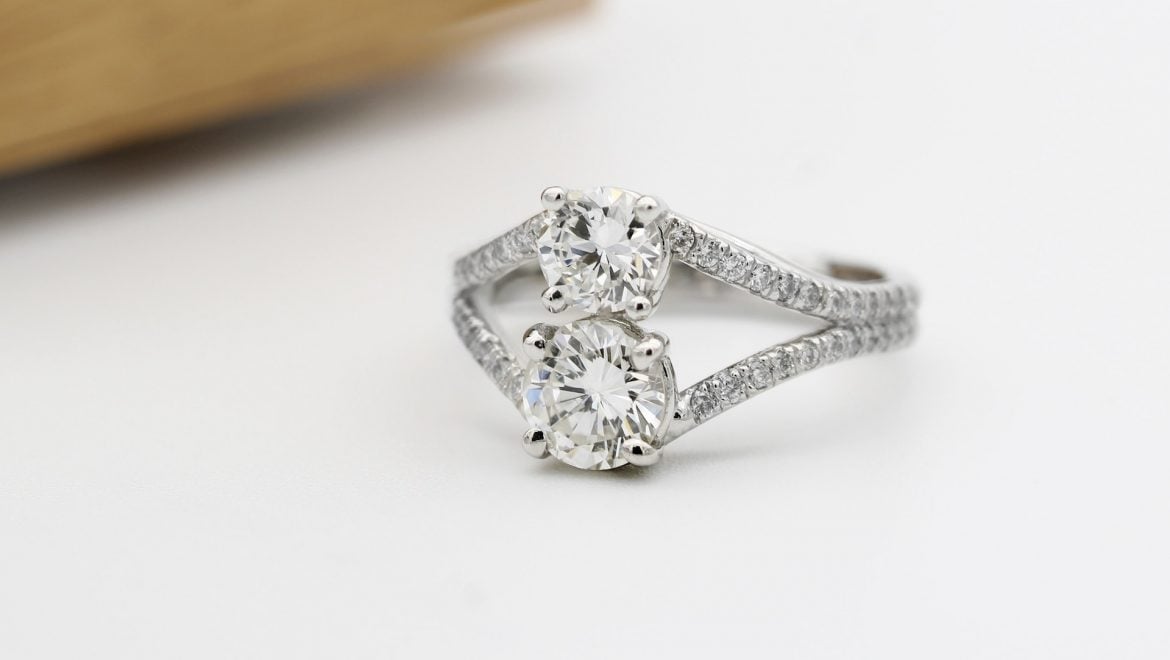What is cubic zirconia?
Cubic zirconia (CZ) is often hailed as the closest synthetic gemstone to diamond. Its colourless gleam, hard exterior and effortlessly elegant appearance makes this stone a favourite for those looking for a more affordable option than diamonds. But what are CZ stones, and can you tell the difference between cubic zirconia and the real deal?
What are CZ diamonds?
Cubic zirconia, the cubic crystalline form of zirconium dioxide, is a more affordable, man-made alternative to the diamond. While laboratory grown diamonds hold the same, or similar, qualities as their natural counterparts, the same cannot be said for cubic zirconia. While lab grown diamonds are formed in the same way as their natural counterparts (just sped up by billions of years), CZ stones are made differently – which, in turn, means they are made up from different properties, making them different to diamonds.
CZ can be made in a variety of colours including a virtually colourless appearance which can only be found in nature via diamonds. Many people are unable to afford the perfect diamond so CZ stones, with essentially the same appearance as diamonds but differing optical, physical, and chemical properties, are a more affordable alternative.
How is cubic zirconia made?
Cubic zirconia is made up of a mixture of high purity zirconium oxide powders, magnesium and calcium. The components are heated at the high temperatures of 2750°C for several hours to ensure everything is melted and all impurities have evaporated. Once the creators are happy that everything is in order, the heating process stops and the mixture cools. It is as this mixture cools that the crystals are formed. The crystals, now CZ stones, are cut and cleaned by being boiled in acid. The acid removes all traces of oil, dirt, and diamond powder.
CZ stones vs diamonds
You may be wondering, if CZ stones look like diamonds, why they are significantly cheaper?’ Well, there are a number of ways in which the stones differ, even if these are small and not necessarily apparent to the untrained eye.
Firstly, price wise, there is a significant difference between the two. According to The Diamond Pro, 1 Carat Cubic Zirconia engagement ring sells for around £10, while a similar 1 Carat Diamond engagement ring that’s well-cut goes for around £2,600. For something that appears exactly the same at first glance, there is quite a significant price difference – this is because of the refractive index, and the hardness of the stone.
A refractive index defines how light passes through the object – a cubic zirconia has a much lower refractive index 2.15 – 2.18, compared with a diamonds, which has around 2.42. This means when light passes through a CZ stone, there is significantly less light cast back. In most cases, the light refracted by a CZ stone gives off a rainbow effect – this is one of the best ways to spot a fake diamond, as diamonds are known for their brilliance, casting a white light reflection across any room. Diamonds shine for a little bit longer and, with their higher refractive index, they shine more brilliantly. They can maintain their shine with fairly limited levels of maintenance – but CZ stones decay rapidly in comparison.
A diamond is the hardest stone known to man ranking a solid 10 on the Mohs scale of hardness – while no man-made gemstone could be harder. This means that a diamond is significantly more durable and long lasting than CZ, which rates 8.5.
How can you tell a real diamond from cubic zirconia?
Despite cubic zirconia being very different from diamond, it is very tricky to tell the difference between the two. The best way is using the refractive index. Shine a light on your diamond – if it casts rainbow reflections, you have a cubic zirconia or another synthesised stone.
A CZ stone is an affordable alternative to a diamond but it is no replacement for the real thing – its dull shine and its lack of durability means that jewellery containing cubic zirconia doesn’t always last, and wears quite quickly. If you’re still struggling to work out whether you have a CZ or a real diamond, why not visit us in our Hatton Garden Store where one of experts should be able to help you? Alternatively you can contact us for more information on CZ stones.




